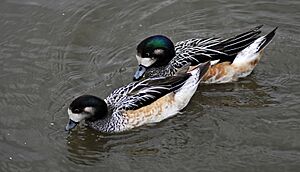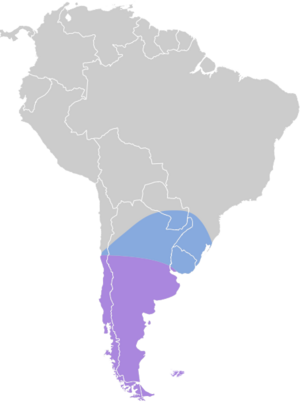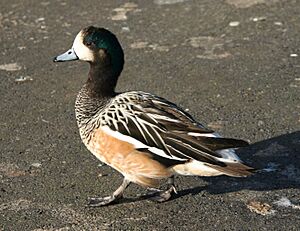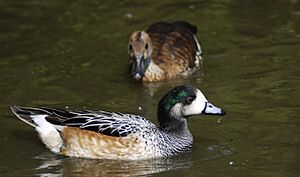Chiloé wigeon facts for kids
Quick facts for kids Chiloé wigeon |
|
|---|---|
 |
|
| Male (rear) and female (front) | |
| Conservation status | |
| Scientific classification | |
| Genus: |
Mareca
|
| Species: |
sibilatrix
|
 |
|
| Synonyms | |
|
Anas sibilatrix Poeppig, 1829 |
|
The Chiloé wigeon (say "Chill-oh-ay WID-jun") is a type of wigeon, which is a kind of dabbling duck. It is also known as the southern wigeon. This bird lives in the southern part of South America, including the Chiloé Archipelago off the coast of Chile.
In its home countries, people call it pato overo ("piebald duck") because of its mixed colors. Sometimes it's also called pato real ("royal duck"). Its scientific name, Mareca sibilatrix, means 'whistler', which might refer to sounds it makes. The name Chiloé comes from the Chiloé Archipelago, where these ducks live.
Contents
What Does the Chiloé Wigeon Look Like?
The Chiloé wigeon is a medium-sized duck. It is about 46 to 56 centimeters (18 to 22 inches) long. Its wings can spread out from 75 to 86 centimeters (30 to 34 inches) wide. An adult bird usually weighs around 800 grams (about 1.7 pounds).
This duck has a very cool head! It has a shiny, iridescent green-blue cap on top. Its beak is bluish-gray with a black tip. The cheeks and forehead are white, and its eyes are dark brown. There's also a white patch near its ears. The back of its neck and head are black.
The chest of the Chiloé wigeon has a cool pattern of black and white stripes. Its wings are gray and white. Male ducks have rust-colored (reddish-brown) sides, while females have lighter brown sides. Their legs and feet are gray.
How to Tell Males and Females Apart
It can be a bit tricky to tell male and female Chiloé wigeons apart. They look quite similar! Males are usually a little bigger and heavier. Their colors might also be a bit brighter, and the green-blue cap on their head might be shinier. But other than these small differences, they look very much alike. Young ducks look like the adults, but they don't have as much rust color on their sides, or sometimes none at all.
Where Do Chiloé Wigeons Live?
These ducks are native to the southern parts of South America. You can find them in places like freshwater lakes, marshes, shallow lagoons, and slow-moving rivers. Sometimes, they even fly to faraway places like South Georgia, the South Orkney Islands, and the South Shetland Islands. These are usually accidental visits.
Chiloé wigeons mostly breed in Argentina, Uruguay, and Chile. They also breed in the Falkland Islands. When winter comes, many of them fly north to southeastern Brazil.
The first Chiloé wigeons were brought to Europe in 1870. They soon started breeding in zoos there.
Because there are many Chiloé wigeons living in the wild, and their population is stable, they are not considered an endangered species. They are listed as "least concern" by the IUCN, which means they are doing well.
How Do Chiloé Wigeons Live?

Chiloé wigeons are omnivores, which means they eat both plants and sometimes small animals. They mainly eat aquatic plants and grass. Sometimes, they also eat algae found along the coast.
Family Life
These ducks usually stay with one partner for life. They breed in the spring in the Southern Hemisphere, which is between September and December. The duck pairs find a small area to build their nest in tall grasses or under bushes.
The female duck lays about eight to ten white or cream-colored eggs. After about 24 to 25 days, the baby ducklings hatch! The father duck helps to raise the ducklings. However, once the young ducks grow their adult feathers (this is called molting), the father usually leaves the family.
Scientists have also seen Chiloé wigeons breed with other types of ducks, like the Philippine Duck, when they are kept in zoos.





